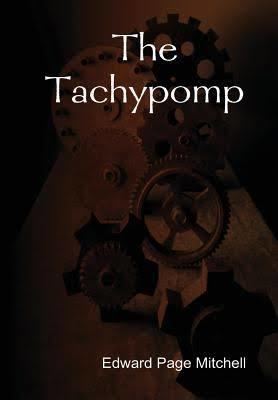Originally published 14 January 2015 | ||
 | ||
Similar The Crystal Man, Fantasia Mathematica, Sci‑Fi and Fantasy Stories Fr, The Devilish Rat (Cryp, The Last Man | ||
The tachypomp by edward page mitchell
"The Tachypomp" is a short story by Edward Page Mitchell originally published January 1874 anonymously in The Sun, a New York City daily newspaper.
Contents
- The tachypomp by edward page mitchell
- Publishing information
- Plot synopsis
- Tachypomp a machine
- Tachypomp in reality
- References
Publishing information
After the original publication in The Sun, the story was reprinted in Clifton Fadiman's Fantasia Mathematica (1958). In 1973, "The Tachypomp" and other stories were reprinted in The Crystal Men: Stories by Edward Page Mitchell, edited by Sam Moskowitz (Garden City, N.Y.: Doubleday and Company, 1973) .
Plot synopsis
The plot revolves around Mr. Furnace’s (the narrator) quest to marry his math professor’s daughter. Unfortunately, the math teacher does not approve of him, as he does not excel in mathematics. The professor sets him a challenge: to discover the principle of infinite speed. The narrator turns to his tutor, and is able to find the solution in the tachypomp. Eventually the professor agrees to allow Mr. Furnace to marry his daughter.
The tutor tells Furnace about several scientific discoveries. These include:
Tachypomp, a machine
The term "tachypomp" refers to a fictional device theoretically capable of attaining infinite speed. The machine itself is a series of trains (or any train-like vehicle) each half the length of the first, stacked vertically. The trains would thus move in tandem, and their speeds would be added to find the speed of the train on top. For instance, if the bottom train were moving 40 miles an hour and the train above that 40 miles an hour, then the speed of the higher train would be 80 miles an hour.
Tachypomp, in reality
Though an interesting idea in theory, the special theory of relativity dictates that the speed of light in a vacuum is absolute and represents an ultimate speed limit for the universe (at least locally). If a Tachypomp were constructed, relativistic principles such as length contraction and time dilation would prevent any component of the system from achieving or exceeding the speed of light.
It is worth noting that the story "The Tachypomp" was written and published before these relativistic effects were laid out by Albert Einstein in 1905. Therefore, the final line of the story, "Still I can see no reason why the Tachypomp should not have succeeded. Can you?" was likely meant in earnest by the author.
